my research interests
Graph theory
The operations of deletion and contraction are crucial to the Tutte polynomial of an abstract graph. So any extension of the Tutte polynomial for graphs embedded on surfaces must also take account of how deletion and contraction behave on surfaces. Following this line of thought, Iain Moffatt and I found that four notions of embedded graphs arise naturally. We are able to give a description of each of these classes in terms of coloured ribbon graphs, and to identify a universal deletion-contraction invariant (that is, a Tutte polynomial) for each of them. Our paper has appeared in the Mathematical Proceedings of the Cambridge Philosophical Society.
Israa Tawfik and I studied the basic properties of graphs embedded on surfaces of positive genus whose corresponding link diagrams have the largest possible number of components. A preprint "Embedded graphs whose links have the largest possible number of components" is available on my articles page, and the paper itself has appeared in Ars Mathematica Contemporanea.
A plane graph is Eulerian if and only if its geometric dual is bipartite. Iain Moffatt and I have extended this classical result to partial duals of plane graphs. We also characterize all bipartite partial duals of a plane graph in terms of oriented circuits in its medial graph. A preprint "Bipartite partial duals and circuits in medial graphs" is available on my articles page, and the paper itself has appeared in Combinatorica.
Recently, Dasbach, Futer, Kalfagianni, Lin, and Stoltzfus extended the notion of a Tait graph by associating a ribbon graph with each state of a link diagram. Iain Moffatt, Natalia Virdee, and I have studied the Seifert graphs: those ribbon graphs of a link diagram which arise from Seifert states. We give a characterization of Seifert graphs in terms of Eulerian subgraphs. We also examine the family of ribbon graphs which arises by forming the parallels of a link diagram, and determine how the genus of the ribbon graph of a r-fold parallel of a link diagram is related to that of the original link diagram. A preprint "On the Seifert graphs of a link diagram and its parallels" is available on my articles page, and the paper itself has appeared in the Mathematical Proceedings of the Cambridge Philosophical Society.
Iain Moffatt and I formulated a definition of 2-decompositions of ribbon graphs, which generalises both 2-sums and tensor products of graphs. Furthermore, we give formulae for the Bollobás-Riordan polynomial of such a 2-decomposition, and derive the classical Brylawski formula for the Tutte polynomial of a tensor product as a (very) special case. A preprint "Expansions for the Bollobás-Riordan polynomial of separable ribbon graphs" is available on my articles page, and the paper itself has appeared in the Annals of Combinatorics.
Given a planar graph there are two distinct and well known methods of generating an alternating link diagram, and in each case the Tutte polynomial of the graph is related to a polynomial invariant (Jones or HOMFLY) of the link. Switching from one of these methods to the other corresponds in knot theory to tangle insertion in the link diagrams, and in combinatorics to the tensor product of the cycle matroids of the graphs. This provides a very interesting explanation of the inability of the Jones polynomial to see knot mutations. A preprint "On tangles and matroids" is available on my articles page, and the paper itself has appeared in the Journal of Knot Theory and its Ramifications.
Mike Eastwood and I discovered a representation of the chromatic polynomial of a graph as the Euler characteristic of a corresponding family of manifolds. Some of the key properties of the chromatic polynomials can be derived from simple algebraic topological methods applied to the manifolds. A preprint "Euler characteristics and chromatic polynomials" is available on my articles page, and the paper itself has appeared in the European Journal of Combinatorics.
History of geometry
Nicole Bloye and I studied the ways in which the meaning of geometry has changed from the classical Greek period to the present day. The Euclidean focus on ruler and compass constructions was intriguing, and had profound consequences. We were particularly fascinated by Newton's brilliant use of the "organic construction" (which is actually the standard quadratic transformation) in resolving singularities of plane curves. A preprint "Newton, the geometer" is available on my articles page, and the paper itself has appeared in the Newsletter of the European Mathematical Society.
Twistor theory
I am currently interested in how the Penrose transform can be used to generate zero-rest-mass fields on space-time from collections of hyperplanes in projective twistor space. These fields have been known about by Roger Penrose and Andrew Hodges for a long time, but deserve further study.
Franz Müller and I studied generalized twistor diagrams as linear SU(p,q)–equivariant operators on tensor products of positive ladder representations. In a paper in the Proceedings of the Royal Society we showed how a sequential composition of elementary diagrams effects the algebraic composition of the operators corresponding to these elementary diagrams.
Sergei Merkulov and I published a paper in Mathematica Scandinavica on the application of twistor techniques in constructing spaces with exotic holonomies. We considered a family of compact complex submanifolds Xt of a complex manifold Y parametrised by t in the complex manifold M. For any holomorphic vector bundle E on Y (such that when restricted to Xt the dimension of the space of global sections does not depend on t), then provided that certain cohomology groups vanish, as t varies in M there is an induced vector bundle on M naturally equipped with a connection with restricted curvature.
I was on the organising committee for the conference, Geometric Issues in the Foundations of Science, held in St John's College Oxford in June 1996, in honour of Roger Penrose. A volume of proceedings, The Geometric Universe, was published by Oxford University Press in 1998: see my books page.
In twistor conformal field theory the Riemann surfaces and holomorphic functions of two-dimensional conformal field theory are replaced by "flat" twistor spaces (arising from conformally flat four manifolds) and elements of the holomorphic first cohomology. The analogue of a Laurent series is the expansion of a cohomology element in "elementary states", and in a paper in the Annals of Global Analysis and Geometry Robin Horan and I calculated the dimension of the space of these states for twistor spaces of compact hyperbolic manifolds. We expressed the problem globally (in terms of the cohomology of a blown-up twistor space), calculated the holomorphic Euler characteristic of this blown-up space, and then used some vanishing theorems to isolate the first cohomology term.
Michael Singer and I studied functionals on tensor products of twistor cohomology groups and found that the use of relative cohomology significantly simplifies the problem of finding contours for the evaluation of (projective) twistor diagrams. Our paper appeared in the Transactions of the AMS.


